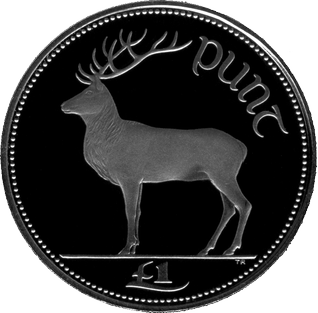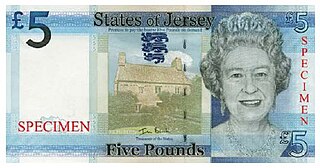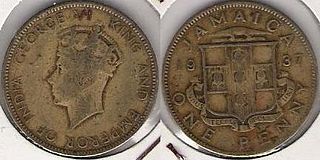Related Research Articles
The Eastern Caribbean dollar is the currency of all seven full members and one associate member of the Organisation of Eastern Caribbean States (OECS). The successor to the British West Indies dollar, it has existed since 1965, and it is normally abbreviated with the dollar sign $ or, alternatively, EC$ to distinguish it from other dollar-denominated currencies. The EC$ is subdivided into 100 cents. It has been pegged to the United States dollar since 7 July 1976, at the exchange rate of US$1 = EC$2.70.
The Kwacha is the currency of Zambia. It is subdivided into 100 Ngwee.

The Australian dollar is the official currency and legal tender of Australia, including all of its external territories, and three independent sovereign Pacific Island states: Kiribati, Nauru, and Tuvalu. As of 2022, it is the sixth most-traded currency in the foreign exchange market and also the seventh most-held reserve currency in global reserves.

Sterling is the currency of the United Kingdom and nine of its associated territories. The pound is the main unit of sterling, and the word "pound" is also used to refer to the British currency generally, often qualified in international contexts as the British pound or the pound sterling.

The pound was the currency of the Republic of Ireland until 2002. Its ISO 4217 code was IEP, and the symbol was £ The Irish pound was replaced by the euro on 1 January 1999. Euro currency did not begin circulation until the beginning of 2002.

The pound sterling is the official currency of the United Kingdom, Jersey, Guernsey, the Isle of Man, British Antarctic Territory, South Georgia and the South Sandwich Islands, and Tristan da Cunha.

The pound, or lira, was the currency of Cyprus, including the Sovereign Base Areas in Akrotiri and Dhekelia, from 1879 to 2007, when the Republic of Cyprus adopted the euro. However, the self-proclaimed Turkish Republic of Northern Cyprus uses the Turkish lira as its official currency.

The pound was the currency of Australia from 1910 until 14 February 1966, when it was replaced by the Australian dollar. Like other £sd currencies, it was subdivided into 20 shillings, each of 12 pence.
The pound is the currency of Guernsey. Since 1921, Guernsey has been in currency union with the United Kingdom and the Guernsey pound is not a separate currency but is a local issue of sterling banknotes and coins, in a similar way to the banknotes issued in Scotland, England and Northern Ireland. It can be exchanged at par with other sterling coinage and notes.

The Fijian dollar has been the currency of Fiji since 1969 and was also the currency between 1867 and 1873. It is normally abbreviated with the dollar sign $, or alternatively FJ$ to distinguish it from other dollar-denominated currencies. It is divided into 100 cents.

The Jamaican dollar has been the currency of Jamaica since 1969. It is often abbreviated to J$, the J serving to distinguish it from other dollar-denominated currencies. It is divided into 100 cents, although cent denominations are no longer in use as of 2018. Goods and services may still be priced in cents, but cash transactions are now rounded to the nearest dollar.

The pound is the currency of Jersey. Jersey is in currency union with the United Kingdom, and the Jersey pound is not a separate currency but is an issue of banknotes and coins by the States of Jersey denominated in sterling, in a similar way to the banknotes issued in Scotland and Northern Ireland. It can be exchanged at par with other sterling coinage and notes.
The pound is the currency of the Isle of Man, at parity with sterling. The Manx pound is divided into 100 pence. Notes and coins, denominated in pounds and pence, are issued by the Isle of Man Government.
The pound is the currency of the Falkland Islands, a British Overseas Territory in the South Atlantic Ocean. The symbol is the pound sign, £. The ISO 4217 currency code is FKP.
The pound was the currency of Tonga until 1967. It was subdivided into 20 shillings, each of 12 pence.

The pound was the official currency of Jamaica between 1840 and 1969. It circulated as a mixture of sterling coinage and locally issued coins and banknotes and was always equal to the pound sterling. The Jamaican pound was also used in the Cayman and Turks and Caicos Islands.
The pound was the currency of the British Solomon Islands Protectorate between 1899 and 1966. It was divided into 20 shillings, each of 12 pence. Initially, sterling coin circulated, supplemented by local banknotes from 1916. In 1920, Australian coins and banknotes were introduced, although local paper money continued to be produced until 1932. When the Australian pound broke its parity to the sterling in 1930 during the great depression, this caused uncertainty in the British territories of the Western Pacific regarding whether their pound unit was a sterling or an Australian pound. This uncertainty prevailed into the mid-1930s and was only resolved when the matter was clarified by King's regulations. The final result was that all the British territories apart from Fiji adopted the Australian unit. As such, the British Solomon Islands Protectorate followed the course of Australia.

The Bank of England, which is now the central bank of the United Kingdom, British Crown Dependencies and British Overseas Territories, has issued banknotes since 1694. In 1921 the Bank of England gained a legal monopoly on the issue of banknotes in England and Wales, a process that started with the Bank Charter Act of 1844 when the ability of other banks to issue notes was restricted.

The Australian one-pound note was the most prevalent banknote in circulation with the pound series, with the last series of 1953–66 having 1,066 million banknotes printed. The first banknotes issued were superscribed notes purchased from 15 banks across Australia and printed with Australian Note and were payable in gold. Upon decimalisation in 1966, it was worth two dollars.
Banknotes were prepared for, but not generally issued by the Bank of Nassau between the 1870s and 1906. The notes are actually quite rare remainder banknotes.
References
- Standard Catalog of World Paper Money, General Issues. 1368–1960. Edited by George S. Cuhaj. Published by Krause Publications.